PRE-RACE NERVOUSNESS
Ron Saetermoe
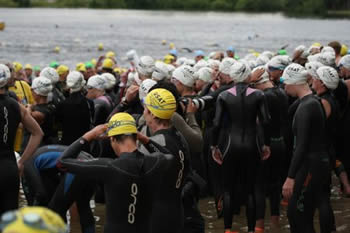 This subject has been written about plenty of times but I thought I’d give you my take on it. First, I’ve been racing since 1983 and have done well over 100 races and I still get nervous. So, if you’re thinking the more you do this the less nervous you’ll get, you’re dreaming.
This subject has been written about plenty of times but I thought I’d give you my take on it. First, I’ve been racing since 1983 and have done well over 100 races and I still get nervous. So, if you’re thinking the more you do this the less nervous you’ll get, you’re dreaming.
Some say the nervousness you feel is a good thing. I don’t know if it is or not. All I know is that I have it. The key thing for me is learning how to channel it and deal with it.
I find that I’m more nervous before “big” races than less important races( DUH!). Makes sense, but if you think about it rationally, this will help reduce the tension before your lesser important races. Stress before the “big” races, not the smaller ones.
Sleep is crucial to performing at your best. The problem is that it’s frequently difficult to sleep the night before a race. So here’s what I do. I aim to sleep as much as possible two nights before the race, knowing that I’m not likely to get too much sleep the night before the race. Then, you’ll at least have some energy still in the tank.
Another ploy I have is to take a nap the day before a race. Now, when I nap I’m only grabbing 20 – 30 minutes. That way it won’t keep me up later that night.
When you’re on the road and sleeping away from your own home it’s best to try to do whatever relaxes you. Go to the spa or steam room, read a book, eat your favorite comfort food, have a glass of beer or wine. Anything that will help you wind down.
So why is it important to get sleep anyway? Won’t the adrenaline carry me through the race? One of the main reasons you want to get plenty of sleep is because the body and mind repair themselves when you’re at rest. If you track your heart rate on a regular basis, notice what your heart rate is when you wake up from a morning of good sleep and another when you didn’t. You’ll find your “resting heart rate” is between 5 to 10 beats faster when you don’t get good rest.
And, yes, the adrenaline may carry you through to the finish but if you’re well rested you’ll always perform better.
RACE PERIOD
Ron Saetermoe
This is what it’s all been leading up to . . . your Race Period. This is when you give your training everything you’ve got. Your volume and intensity max during this period; and it is intense!
While “stuff happens” you really need to try to stay on task during this period. No slacking off now. You may be getting nervous about your race at this point and wondering if your training was adequate. If you’re a typical “A” type triathlon personality you’ll never feel like you’ve done everything you could have to prepare.
You must be very careful during this period NOT to over train, and to make sure you get plenty of rest on your recovery days. Too many athletes think that more is better and while you will be doing more volume you also need to get your rest or all of the hard work simply won’t take.
Go over the race on paper (or computer) and in your head. Review the website and any course maps, rules, directions, etc. Go to the race site in advance if you can and do the course.
I’m going to try to get a slot at IM St. George on May 1st so a bunch of us are going out to St. George to ride and run the course in March. This will give us an edge come race day.
You’ll either pull back on the resistance training or end it all together during this period – you’re probably totally ripped anyway by now! In addition, this phase includes the CRITICAL taper prior to your event.
The length of your taper will depend on the event you’re training for. Here’s what I like to do:
Sprint: 3 days
Olympic: 1 week
½ IM: 2 weeks
IM: 3 weeks
By now you should have your nutrition completely dialed in. Don’t change anything at this late date. Stay focused.
The key things about the Race Period are:
– Don’t miss workouts unless sick or injured
– Continue to increase your training volume and intensity
– Resistance (strength) training ends
– “Brick” workouts should be getting longer in distance
– Recovery is critical
– Taper
Here’s what the ideal Triathica year looks like:

Again, we feel that three, three-week cycles within each period is optimal for building fitness and recovery. The time to build strength, speed and endurance is upon you. Make the best of it!
Cheers!
Ron
BREAKING THROUGH A PLATEAU
Jarrett Pflieger
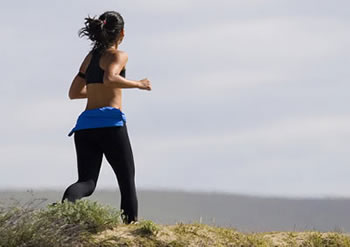
Triathletes are in a constant battle against themselves. We go out and train, beating up our bodies, with the knowledge that all our hard work will translate into adaptations that will enable us to swim, bike, and run faster and longer. There is no greater feeling than continuously going out and improving upon your performances from the weeks, months, and years previous.
Unfortunately, this feeling does not last forever. Every triathlete eventually hits a point where, no matter how hard they train; they can’t seem to improve even a small amount, if at all. This is known as a plateau and is common among all types of athletes. There are several reasons for this and ways to get around plateaus, so there’s no need to panic.
1. Stagnant Training Routines
Many of us like to stay in our comfort zones. We get into a comfortable training routine that we like and have shown us good performance gains in the past. Just because it has worked does not mean it will work forever. Your body is very good at adapting to outside stress, so if you maintain the same routine for months without switching things up, your body will stop responding to the stress and you will not see the gains you want.
To prevent this, you need to change things around every once and a while. When building a training plan, you need to vary not only distance, but also intensity, volume, rest periods, etc. A good periodized training plan should incorporate all these aspects and keep your body constantly guessing.
2. Poor Diet
Your body is a machine and it needs fuel to function properly. This is even more important for athletes. Your performance will reflect the kinds of food you put into it. You should stick with calorically dense foods like fruits, vegetables, complex carbohydrates (oatmeal, whole wheat, brown rice, quinoa, etc.) and lean protein (chicken, fish, lean beef, turkey).
Try to stay away from processed foods and sugars as much as you can. An occasional treat will not hurt, just stick with a 90/10 rule. Follow a sensible diet 90% of the time, and feel free to eat whatever you want 10% of the time, in moderation, of course.
3. Overtraining
The amount of rest you give your body is just as important as your training. Without proper rest, your body will not have time to absorb the training and make the adaptations that lead to increased performance. If you are constantly fatigued, sore, and/or not hitting your target times in training, there is a good chance you are not giving your body enough rest. Too much rest is better than too little. Just listen to your body and dial it back a few notches if you need to. In this case, less is more.
Although there are some reasons for plateaus that cannot be overcome (age, injury, genetics, etc.), most of the time all it takes is a small adjustment in training or lifestyle to keep the gains coming. Listen to your body, get a good coach, and you will continue setting PR’s and getting the most out of your training.
ABOUT THE “BONK”
Ron Saetermoe
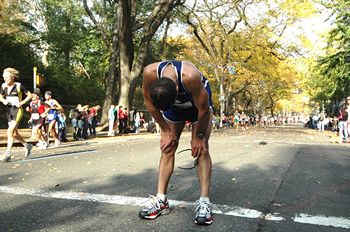 I’m an expert about the “bonk.” Ask me anything!
I’m an expert about the “bonk.” Ask me anything!
For example, did you know there are different kinds of bonk? Sure, you have the nutritional bonk, the cardio bonk, the muscular bonk and the run into the wall bonk. I’ve experienced all four varieties.
One of my Ironman mentors, Chris Johnson (qualified, and completed, 15 consecutive Ironman World Championships) purposely goes out and bonks. This gives him an idea of how hard he can push himself before he bonks. Aren’t we triathletes nutty?
The first time I experienced any kind of bonk was during my first marathon back in 1979. I had heard of “hitting the wall” but didn’t think there was anything you could do about it – it just happens. Of course, I didn’t know back then that it probably would have been a good idea to eat something or at least drink the Gatorade they had on the course.
I bonked in 2008 during my first Ironman: Ironman Coeur d’Alene. This was a muscular bonk. Not to say I wouldn’t have bonked anyway, but I wasn’t able to finish my training plan because I broke two ribs five weeks prior to my race. On second thought, let’s blame it on that.
I bonked again in 2008 at Ironman Arizona. This time it was a nutritional bonk. My personal problem when going hard is taking in anything solid, even gels. For some reason my stomach just doesn’t like anything solid. I had my gels and even made peanut butter and jelly sandwiches but couldn’t stomach any of them.
The bike portion of the race was fine but when I got to the run I was toast! I had nothing in the tank. My legs felt fine and my heart rate was fine but I had no energy. I started walking and was able to pick my pace up throughout the race only because I was able to take some calories in.
Last year Lar Dog, Larry Davidson, turned me on to Infinit. I mix it up to triple strength and sip it and chase it with water. Voila! No bonk! I’ve practiced and raced with it numerous times and not only don’t I bonk but I also don’t get hungry. Problem solved.
I’m sure there are plenty of other fine products out that can perform the same miracles, but for my money, Infinit is it!
BUILD PERIOD
Ron Saetermoe
Last week I discussed the Base Period of your training year, this week we move on to the next period, which is the Build Period.
Once you’ve finished with the Base Period your fitness should be quite good. Now you’re going to continue building your endurance and speed. Your training load increases and missed workouts should be avoided unless sick or injured.
You should still be hitting the gym during this period and increasing the effort in your resistance training. I generally do 10 different exercises in my resistance training – two sets of each exercise. You may be increasing your sets, reps, weight or all three.
Be sure you’re incorporating speed, power and endurance workouts in all three sports during this period, and don’t forget to continue doing bricks (swim/bike and/or bike/run).
During your long rides and runs be sure to test your nutrition and get it completely dialed in so you know what you’ll need to complete your race (if you’re doing the long stuff).
The key things about the Build Period are:
– Don’t miss workouts unless sick or injured
– You continue to increase your training volume and intensity
– Resistance (strength) training increases
– “Brick” workouts should be getting longer in distance
– Don’t forget to incorporate recovery days and weeks in your plan (your fitness takes hold when your body is at rest)
Here’s what the ideal Triathica year looks like:

Again, we feel that three, three-week cycles within each period is optimal for building fitness and recovery. The time to build strength, speed and endurance is upon you. Make the best of it!
Cheers!
Ron
EVERY RUNNERS NIGHTMARE: THE SIDE STITCH
Jarrett Pflieger
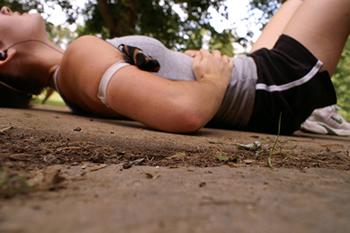 Side stitches, cramps, whatever you want to call them, they hurt. Every runner, at one point of another, has had to battle through a side stitch during training or racing. The pain can become so bad it forces us to slow down, or in extreme cases, stop completely. What exactly causes these side stitches and are there ways to make them go away when they happen, or better yet, prevent them altogether?
Side stitches, cramps, whatever you want to call them, they hurt. Every runner, at one point of another, has had to battle through a side stitch during training or racing. The pain can become so bad it forces us to slow down, or in extreme cases, stop completely. What exactly causes these side stitches and are there ways to make them go away when they happen, or better yet, prevent them altogether?
A side stitch, technically known as exercise-related transient abdominal pain (ETAP), is not a buildup of gas or cramping of the abdominal muscles. It actually originates in the diaphragm, the muscle that helps you breathe and separates your organs from your chest cavity. You see, when you breathe in, your diaphragm naturally moves downward to increase the capacity of air your lungs can take in. As your diaphragm moves up during exhaling, it brings your organs up with it.
The problem is when you run, you have gravity working against you, even more so than when you’re standing still. When you take each stride while running, your organs are pulled down by gravity, but your exhaling causes your diaphragm to move up. These opposing forces cause the ligaments and muscles connecting your organs to your diaphragm to stretch, which is very painful. This phenomenon can then make your diaphragm to go into spasms, which causes the painful cramps we often experience.
Once a side stitch comes, it is hard to get rid of. You can try sticking a few fingers under your ribs to try to massage the muscles and ligaments. Deep breathing also helps get rid of the stitch faster, since shallow breathing usually prolongs the spasming. If all else fails, slow down or stop until the pain leaves. If you are made of steel and feel no pain, just push through it, the choice is yours.
One way to prevent side stitches completely is to change your breathing pattern. If you tend to exhale mostly when your right foot is hitting the ground, your large liver could be causing more pain as it is pulled away from your diaphragm. Organs are smaller on the left side, so try exhaling when on left foot strikes.
Proper hydration and warm-up is also key in preventing the side stitch. Dehydration, sodium deficiency, and cold muscles can make the side stitch come faster and be harder to get rid of. Hopefully you can implement some of these tips and say farewell to your side stitch woes for good.
POST WORKOUT HABITS: JACUZZI, ICE BATH, OR NEITHER?
Jarrett Pflieger
You just had your hardest training session of the week, your muscles are screaming, and you need relief now! Nothing looks more appealing than the hot steam rising up from a hot tub, urging you to come take a dip and ease your pain.
Although a nice warm bath or Jacuzzi feels great after a hard training session, it may not be the best thing for your muscles. In fact, it may even put a damper in your recovery. After a hard workout, you actually damage your joints and muscles. No, not serious damage like an injury, but micro-trauma that causes your muscles to become inflamed and swollen. Your body healing from this is what allows you to adapt and become stronger, faster, etc.
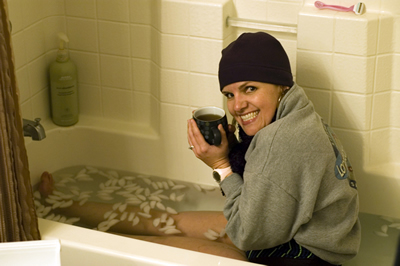 The faster you can reduce this inflammation and swelling, the sooner you will recover and be ready for your next workout. The best way to do this is with cold, not hot. A cold- water bath following exercise is believed to reduce swelling and breakdown of tissue, constrict blood vessels, and flush out waste products from your muscles like lactic acid. Scientific studies are mixed on the subject, but athletes that use cold-water baths swear by it. We say cold water, and not ice water, because the water does not actually have to be ice cold to get the benefits. “Ice” water can actually be less effective than just “cold” water that is around 50-60 degrees. Plus, it is much more tolerable.
The faster you can reduce this inflammation and swelling, the sooner you will recover and be ready for your next workout. The best way to do this is with cold, not hot. A cold- water bath following exercise is believed to reduce swelling and breakdown of tissue, constrict blood vessels, and flush out waste products from your muscles like lactic acid. Scientific studies are mixed on the subject, but athletes that use cold-water baths swear by it. We say cold water, and not ice water, because the water does not actually have to be ice cold to get the benefits. “Ice” water can actually be less effective than just “cold” water that is around 50-60 degrees. Plus, it is much more tolerable.
The time you should spend in the water varies in opinion. The most common duration is immersion for 10-14 minutes, but like most things, it probably varies depending on the individual. Just experiment with cold-water immersion in the bathtub, pool, ocean, etc. See how your legs feel the next day compared to what you felt like without cold-water therapy.
Another practice is to alternate cold and hot water for several cycles. For instance, try alternating one-to-two minutes cold, two minutes hot for around three cycles. Only submerge your legs and lower torso when trying any of these methods. It can be dangerous for your whole body to experience temperature change this rapidly. You should never try any of these methods without thoroughly cooling down after a workout for around 10-15 minutes. It is like putting hot metal in cold water, it just doesn’t mix well.
Try to experiment with some different techniques and record your results so you can go back, review your notes, and see what worked the best. One thing is for sure, the worst thing to do after a workout is to not cool down and just plop on the couch. You will take much longer to recover and will miss out on vital performance gain opportunities.
RACE REPORT: CARLSBAD HALF MARATHON
Ron Saetermoe
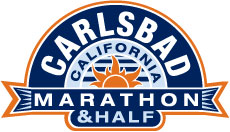 We had a great ride Saturday, January 23rd. Two years ago Larry (Lar Dog), Kirk Matkin (Matkin Design) and I made the same ride. This year it was Larry, Daniel, Camille and I.
We had a great ride Saturday, January 23rd. Two years ago Larry (Lar Dog), Kirk Matkin (Matkin Design) and I made the same ride. This year it was Larry, Daniel, Camille and I.
The idea was to ride down to Carlsbad to pick up our bibs for the half marathon the following day. Since it rained practically all week prior, our ride was in doubt, but the clouds broke and we went for it. I picked up a few more miles, and hills, just for fun. About 85 for me total.
I picked Lar Dog up at 6:00 a.m. Sunday for our 7:30 a.m. half-marathon start. The air was clear and crisp. I think it was high 40’s around start time and mid-50’s by the time we finished. Perfect!
Anyway, on the way down Larry and I were both complaining about how we felt after our spirited ride the day before. Neither one of us felt a PR coming on.
Larry was shooting for a 7:00 minute pace and I was shooting to finish – period!
We were seeded in the first wave (pretty cool idea, actually) and hit the first mile pretty hard. There was a large uphill climb over the I-5 so our first mile was 7:15. We were running along side a 1:35:00 pacer, which would be a great finishing time for me.
Mile two was quite a bit faster because we had to come down the same hill. Mile two: 6:30.
After that I simply waved goodbye to the Dog. Larry did a great job maintaining his 7:00 pace, but I fell back. My quads were toast from the day before. And while it hurt to run I knew that it would pay dividends later.
If you’ve never raced in Carlsbad you probably don’t know that the town really gets behind their sporting events (including the Carlsbad Triathlon). They literally close down the Pacific Coast Highway. The run along the ocean is great and inspiring.
Anyway, throughout the race I passed the 1:35:00 pacer guy, then he passed me, then I passed him. That’s pretty much how it went all morning. The crazy thing is that no one was running with him that I could see. I wouldn’t have run with him because he had no idea how to pace. One mile he’s running 8:00 pace and the next he’s at 6:30. What a goof!
The race seemed long and my pace slowed as the miles clicked by but I managed to finish in 1:37:51 (7:28 pace), which was good enough for 20th out of 225 finishers (9%).
I’ll take it!
BASE PERIOD
Ron Saetermoe
Two weeks ago I discussed the Adaptation Period of your training year. Most triathletes are probably still in this period now and looking forward to the Base Period.
The base period is when you’ll start building your “base” fitness, which will carry you through the rest of the year. At Triathica, all of our periods last nine weeks, but if you have time in your training schedule, it would do you good to add a couple weeks here in the Base Period.
By now your body should be quite adapted to a regular training regimen. You may still experience some muscle soreness, but it shouldn’t be as bad. Continue the hot/cold treatment to help relax the muscles and reduce the swelling.
One week from now I’ll be beginning my Base Phase of training. Keep in mind that no one trains exactly according to the ideal schedule. There are many factors that impact it. Family commitments, business travel, illness and other races. For this reason, you’ll need to back off on your training from time-to-time. When you do this, don’t try to make up for lost workouts. Depending on how many days you’ve missed you may have to ramp back up slowly.
I’ve been doing some half marathons so that obviously takes me out of my normal training routine. When it does, I gradually return to my training plan.
The key things about the adaptation period are:
– You attempt to stay on your training plan as much as possible
– You increase your training volume and intensity
– You regularly include resistance (strength) training
– You shouldn’t be as sore as you were in the Adaptation Period
– You include “brick” workouts every week (one to two)
Here’s what the ideal Triathica year looks like:

Again, we feel that three, three-week cycles within each period is optimal for building fitness and recovery. The time to build strength, speed and endurance is upon you. Make the best of it!
Cheers!
Ron
WHY TRAIN WITH A HEART RATE MONITOR?
Jarrett Pflieger
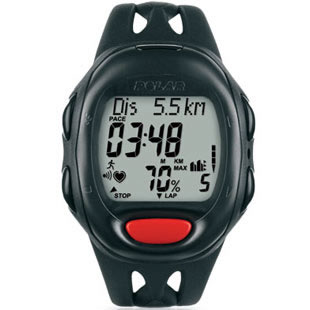 A heart rate monitor is a great tool that can make your training more efficient and increase performance, but many athletes out there haven’t taken the step to start using one. Heart rate monitors are easy to use, fairly inexpensive, and provide one of the largest bangs for your buck in terms of performance gains. Why so many continue to train without one is baffling, but hopefully this article will help some of you take that next step.
A heart rate monitor is a great tool that can make your training more efficient and increase performance, but many athletes out there haven’t taken the step to start using one. Heart rate monitors are easy to use, fairly inexpensive, and provide one of the largest bangs for your buck in terms of performance gains. Why so many continue to train without one is baffling, but hopefully this article will help some of you take that next step.
So why is a heart rate monitor so useful anyways? For one, it gives you a relatively accurate picture of what is going on in your body during training. You may think you are able to sustain a certain pace because you feel good, but a few minutes later you have to slow down or stop altogether. Heart rate monitors can prevent you from going out too hard and not finishing strong in training or races. On the other hand, they can also make sure you aren’t going too easy on yourself. Once you establish your personal heart rate training zones, you will know approximately what heart rate range you should try to sustain for different distances. Knowing your zones will help you pace yourself better, making your training more efficient and ensuring you give your all in races.
So how does one establish their heart rate zones? Well, each individual’s zones are different and vary from sport to sport (swim, bike, run, etc). That is why equations to determine your max heart rate like “220-age” are complete nonsense. There are some 50 year olds out there with higher heart rates than some 20 year olds. Max heart rate mostly depends on genetics. There are several methods to find your max heart rate in a sport.
Personally, I like to do a graded test where I start at a certain pace and keep increasing it every minute or so until I can’t go anymore. This gives a fairly accurate measure of your max heart rate, but it can also be very dangerous if you have any kind of health issues, some you may not even be aware of. The safest method would be to do the same test but stop short of maximum (8-9 out of 10 on the perceived exertion scale, 10 being absolute maximum). You can then estimate your max heart rate to be a few beats above that. Please consult a professional before performing a max heart rate test.
Once you know your max heart rate, you can then break it down into training zones. I like to use five zones, zone one being 50-60% of your max heart rate and zone five being 90-100% of your max heart rate. Then I experiment to see what my pace is at certain zones, and how long I can stay in the zones.
Another helpful number to know it your anaerobic threshold which is the point which your body produces more lactic acid than it can use, causing the burn in the muscles and eventual fatigue. This usually occurs around 65-95% max heart rate depending on the individual. The most successful athletes know what their AT is and can hold close to that pace throughout a race. Most of your training will be below this intensity, but it is still good to know. You can determine your AT by doing a 30-45 minute time trial since most athletes can sustain their AT for around that amount of time. Make sure the time trial is hard and you leave no juice in the tank. After the test, your average heart rate and average pace would be a good estimate of your AT.
Although you can’t really train to increase your max heart rate, you can train to increase your AT. When your AT increases, you are able to maintain a faster pace with less pain and fatigue. This, of course, translates into faster race times. Without a heart rate monitor, none of this type of training is available to you. It is best to not purely rely on the monitor, but also go from how your body is feeling. Once you can use the two in unison, you will be well on your way to setting new personal records.


